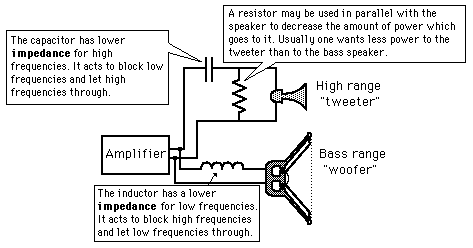
 |
|
Crossover Networks for Loudspeakers Most loudspeakers use multiple drivers and employ crossover networks to route the appropriate frequency ranges to the different drivers. 
|
|
Crossover Elements
|
|
Two-Way Crossover Combinations of capacitors, inductors, and resistors can direct high frequencies to the tweeter and low frequencies to the woofer. This amounts to filter action. A two-way crossover network divides the frequency range between two speakers.  |
|
Three-Way Crossover Combinations of capacitors, inductors, and resistors can direct high frequencies to the tweeter and low frequencies to the woofer. This amounts to filter action. A three-way crossover network divides the frequency range between three speakers.
|
NEXT - Speaker fundamentals
|
Loudspeakers: |
COLUMBIA ISA
columbiaisa@yahoo.com